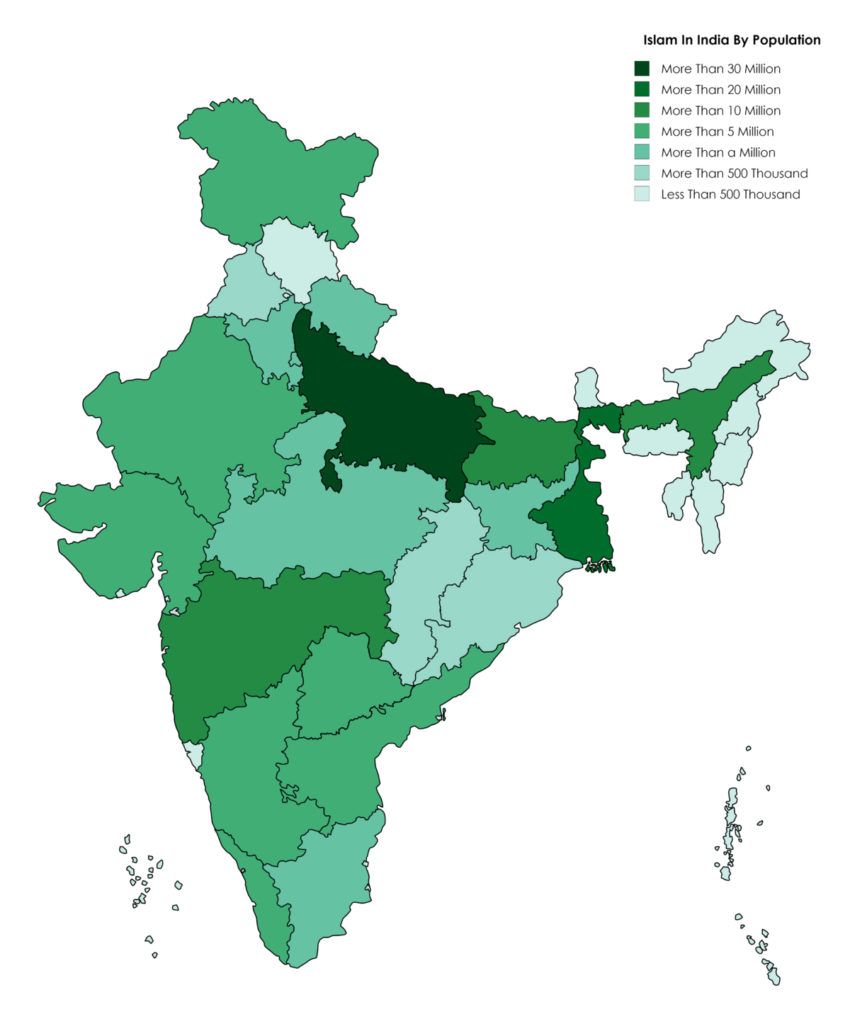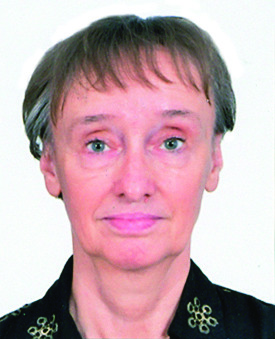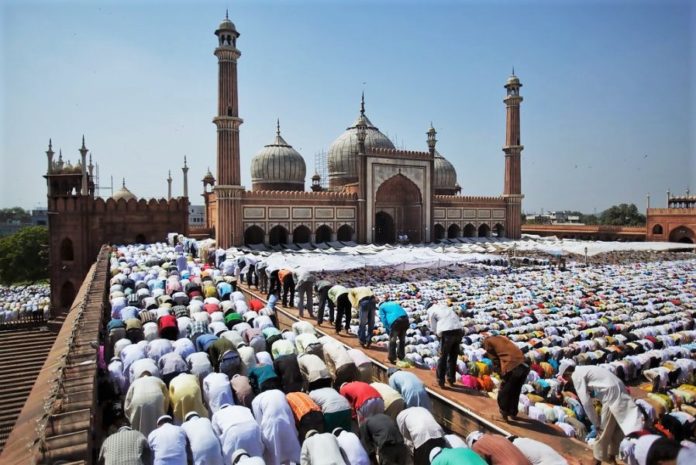With the largest population of Muslims in the world, Islam is the second largest religion in South Asia with about 600 million Muslims, forming about one-third of all Muslims of South Asia’s population. The dominant religion in half of the South Asian countries (Afghanistan, Bangladesh, Maldives and Pakistan), in India Islam is the second-largest religion while in Sri Lanka and Nepal it takes third place.
Islam existed in South Asian communities along the Arab coastal trade routes in Sindh, Gujarat, Malabar, and Ceylon. Arab traders had visited the coasts of the subcontinent from ancient times, long before the beginning of Islam. The Arab traders came to the sea coasts of India and carried Indian goods to European markets by way of Egypt and Syria. Thus, it was through their merchants that India and Arabia came to know each other initially. As soon as the religion originated and had gained early acceptance in the Arabian Peninsula, it was brought to India by the Arab traders long before any Arab army reached the frontier of India. The Barwada Mosque in Ghogha, Gujarat was built before 623 AD, Cheraman Juma Mosque (629 AD) in Methala, Kerala and Palaiya Jumma Palli (630 AD) in Kilakarai, Tamil Nadu are three of the first mosques in South Asia which were built by seafaring Arab merchants. A special example for such early contacts is the coast of Kerala in South India. Kerala Muslims or Malayali Muslims from north Kerala are generally referred to as Mappilas. Interestingly and very much unlike other parts of South Asia, the caste system does not exist among the Muslims of Kerala. Other than the rest of Muslims in the subcontinent they follow the Shafi school of Islam as Arabs do.

The connection between Sindh and Islam was established by the initial Muslim missions during the Rashidun Caliphate. Al-Hakim ibn Jabalah al-Abdi, who attacked Makran in the year 649 AD, was an early partisan of Ali ibn Abu Talib. During the caliphate of Ali, many Hindu Jats of Sindh had come under influence of early Shi’ism and some even participated in the Battle of Camel and died fighting for Ali. Under the Umayyads (661–750 AD), many Shias sought asylum in the region of Sindh, to live in relative peace in the remote area. After the Islamic conquest of Persia was completed, the Muslim Arabs then began to move towards the lands east of Persia and in 652 captured Herat. In 712 AD, a young Arab General Muhammad bin Qasim conquered most of the Indus region for the Umayyad empire, to be made the “As-Sindh” province with its capital at Al-Mansurah. But Qasim left Sindh three years later and for another two hundred years Muslims remained a small community in Sindh. By the end of the 10th century AD, the region was ruled by several Hindu Shahi kings who would be subdued by the Ghaznavids during the course of the 11th century. Islam arrived in North India in the 12th century via the invasions of Ghurid conquest and has since influenced India’s religious and cultural heritage. The Ghurids were a dynasty of Iranian origin from the Ghor region of present-day central Afghanistan. The dynasty converted to Islam from Buddhism after the conquest of Ghor by the Ghaznavid Sultan Mahmud of Ghazni in 1011. The Ghurid dynasty overthrew the Ghaznavid Empire in 1186 when Sultan Mu’izz ad-Din Muhammad of Ghor conquered the last Ghaznavid capital of Lahore.
The Delhi Sultanate (1206–1526) and the Mughal Empire (1526–1857) have ruled most of South Asia for centuries. Despite this long time Muslims by the end of Muslim rule in India consisted of not more than 20% of the Indian population clear proof that Islam was neither spread by the sword as it is stated sometimes nor did the Muslims rulers in Delhi, Agra or Lahore aim to convert the entire Indian population. While there may be instances of conversion to Islam in order to further one’s professional career in the Moghul administration or the army, it is well documented that Hindus reached the highest postings in administration as well as in the Moghul army. Brahmin bureaucrats had a high status at the Mughal court. Akbar’s finance minister, Raja Todar Mal, was valued for bringing the best practices of the Rajputs to shape Mughal economic policies.
The Islamisation of South Asia in general was very slow. The process can be seen as a mixing of already present ideas and rituals with the new Islamic ones. It has been described as consisting of three different features: inclusion, identification and displacement. In the inclusion process Islamic personage were added to Indian cosmology. In the identification process the Islamic agencies fused with the Indian deities. In the displacement process the Islamic agencies took the place of the local deities. This explains how Indians retained many of their pre-Islamic practices. The premier challenge to the purity of Islam in medieval South Asia had neither been from the Moghul court nor from the Maratha raids, but from the rural converts, who were ignorant of Islamic requirements, and from the influence of Hinduism in their lives. Indians relied spiritually on magic and were reported to participate in Durga Puja, worship of Sitala and Rakshya Kali and resorting to Hindu astrologers. In many places Islam was viewed as just one of several methods to seek redress for ordinary problems by ordinary people.
These nominal conversions to Islam, brought about by regional Muslim polities, were followed by reforms, especially after the 17th century, in which Muslims integrated with the larger Muslim world. Improved transport services in the nineteenth century brought Muslim masses into contact with Mecca which facilitated reformist movements stressing adherence to the Quran that most Muslims were unable to read and understand and making people aware of the differences between Islamic commands and their actual practices.
Three elements were amalgamated in the making of Muslim communities in India, namely conquerors who came from the north-west, immigrants, and local converts. The conquerors and their entourage had a sense of higher rank and superiority as it was they who wielded political power. Arab, Persian, Turkish, Central Asian, and Pathan immigrants, who came to India to make careers for themselves, were treated as if they shared a common ethnic background, and were integrated with the conqueror class as the ruling elite. Local converts, on the other hand, were treated as being lower down the social ladder and never accorded an equal place in the ethnically divided Muslim society. Thus, ethnic identity was more powerful in dividing Muslim society than the religious factor was in unifying it. Locally converted Muslims were excluded from high positions and were despised by their foreign (Muslim) brothers.

During the 19th century. Sayyid Ahmed’s Jihad (AD 1831) and the Bengal Faraizi revivalist movements strove to purify Islam of Hindu rituals and customs. Their ultimate goal was to establish an Islamic state in India and to unite Muslims into one community on the basis of religion. Two factors played an important role in reinforcing the creation of a separate identity amongst Indian Muslims. They were, firstly, the activities of Christian Missionaries and secondly, the Hindu reformist and revivalist movements. Muslims felt threatened by both. The fear of Muslims being converted into another faith, and of being dominated by others, led the ulema to organize themselves ‘to save Muslims from extinction’. Recognizing the authority of the ulema, Muslims turned towards them for guidance. They sought “Fatwa” over whether they should learn the English language, serve the East India Company, and regard India as Dar-ul-Islam rather than as Dar-ul-Harb. As has been mentioned before, the differentiation between Hindus and Muslims began during British rule and was connected to the introduction of census when respondents had to decide if they were Hindu or Muslim, to which caste or tribe they belonged. The introduction of voting and the idea of numerical minority and majority sharpened the awareness of Muslims especially the Muslim nobility with their claim to power that in a system based on numerical majority and with a sharp division between the different religions they had but a scant hope to be elected and become or remain part of the ruling circles. From there onwards, political interests of Muslims and Hindus became opposite, access to political representation, to education and jobs became dependent on religion. With no chance of becoming a majority and Hindus unwilling to compromise the idea of politically separating Muslim majority areas into a separate state was born. Thus, external and internal challenges brought the Muslims of India closer together. Religious consciousness paved the way towards their separate identity.
Contributed by:

Dr. Bettina Robotka, former Professor of South Asian Studies, Humboldt University, Berlin, Editor of the Defence Journal and a Consultant to the Pathfinder Group.





